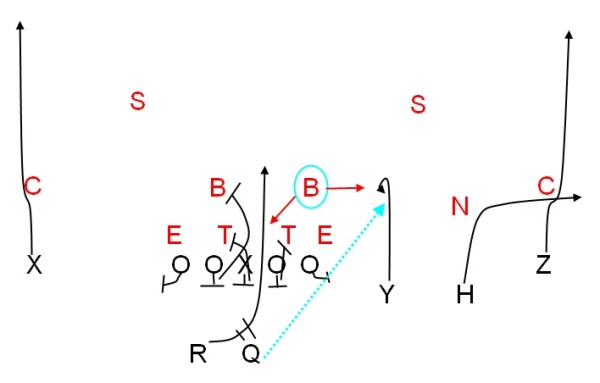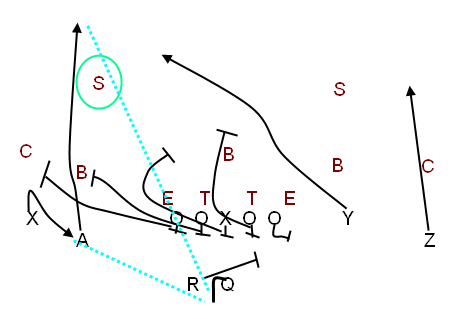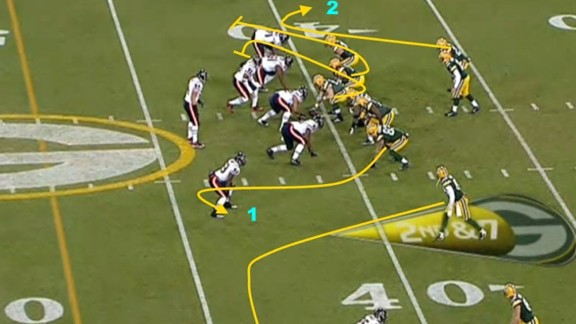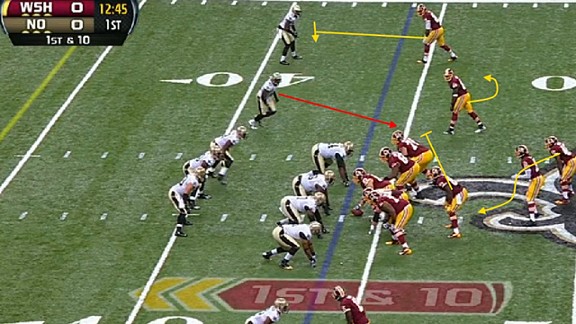By Eddie Weekley [baller7345]
People always complain about Madden’s plays and how they wish they had better plays, or a play editor to make better plays. However, for the most part Madden does a good job of representing NFL passing concepts and NFL running concepts. Curl flats, smash, four verticals, drive, shallow cross, mesh, bench, and the rest of our familiar set of passing concepts is what you’ll see ran on Sundays and they work just fine in Madden for those that truly understand what they are trying to do. However, that doesn’t mean there are areas that Madden can’t improve their play selection and how plays are called in general. We are going to look at an innovation that is sweeping through football that needs to be seriously looked into by EA, packaging plays.
Packaging plays, what is it? Well it’s an idea that jumped up out of college spread and air raid offenses as a way to make sure the offense always has a favorable matchup. The most famous packaged plays is Dana Holgorsen’s Stick-Draw that helped him make his variation of the air raid offense so explosive at Oklahoma State for years and is a big reason WVU was able to put up 70 on the Clemson Tigers in the Orange Bowl. To understand what this is I’ll provide you a play diagram of the famous Stick-Draw
Stick-Draw

This diagram shows exactly what the two packaged plays are trying to accomplish. First and foremost as you can see from the play diagram the blocking isn’t a pass blocking scheme. The Stick-Draw is blocked like a running play even though it has the option to pass in it. They are playing off of the Mike line backer and whatever he does post snap decides how the play is going to unfold. If the Mike crashes in to take away the run post snap you simply throw to the stick. The defense is set up to lose right from the snap. While many people know that being able to adjust at the line of scrimmage to presnap reads differentiates between average and elite QBs that still can be wrong. These type of concepts where you package a quick passing concept with a run play and read off of a defender is instead waiting for the defense to truly show its hand allowing you to never be wrong. It’s option football with a whole new twist and its quickly taking over college football.
Another example of packaging plays includes:
Y-Cross-Quick Screen

This one is another Holgorsen invention where he packages the popular air raid Y-Cross concept which aims to act as a weak side flood with the ever popular quick screen to the flanker. Again you see this isn’t like combining a bubble screen with another concept but instead is a full on screen with pulling linemen and everything that is packaged with the Y-Cross passing concept. This time we are reading off of the safety on the screen side. If he crashes down to take away the screen we simply throw to the cross thanks to the void the safety just left behind and if he hesitates and stays back we take the numbers advantage on the screen all day long. The safety is wrong even before the play begins because there is no right decision.
You may now be saying that even though those were very interesting what to they have to do with NFL play calling, those are both from college offenses that are very college oriented. You’d be right these two are ran by college teams but that doesn’t mean packaged plays haven’t entered the NFL. Enter the Green Bay Packers Stick-Slip Screen:
Stick-Slip Screen

This is a take on the Stick –Draw made famous by Holgorsen and looks to play off the Mike just as Stick-Draw does. It’s also a complete screen blocking scheme right from the start so it’s not like this is simply packaging two different short concepts into one play. The goal is to throw where the Mike isn’t, if he goes after the stick route then you simply take the numbers advantage and throw to the screen as was the result of this particular play. If the Mike crashes towards the screen to break it up you now have the flat defender in a position where he has to defend two players which is impossible so the defense loses even before the ball is snapped. This particular play resulted in a 32 yard screen pass by Ryan Grant.
Ok, now we enter week one of the 2012 NFL season and the Redskins open up the game by throwing a lot of short quick screens. To the casual observer this simply looks like a plan to get Griffin some confidence and to get him into a rhythm in his first start. However when you look closer you see that these simple looking screens weren’t really simple screens they were a take on the zone read where instead of reading the play side DE they were reading the safety and either running the ball if he goes towards the screen or throwing if he crashes in to break up Shannahan’s famous inside zone run.
Quick Screen-Inside Zone

This particular play is something that you’d only see in college spread offenses a few years ago but now one of Shannahan, one of the older West Coast coaches, has implemented it into his scheme. It was probably added due to Griffin’s comfort level with it the concepts behind it but the simple fact is that it is there. These concepts are leaking into football at every level and are something EA should be looking into adding in the future of their football games. This is the new wave of offensive innovation and if EA doesn’t want to be left behind they’ll get in the film room and begin drawing us up some packaged plays.
Sources for Images
Dana Holgorsen’s Draw Stick Play
“Packaged” Plays and Rethinking the Concept of Modern Play Calling
Back to School: How Mike Shanahan is Using RG3’s College Offense With the Redskins

Ever heard of illegal man downfield? You can’t have inelligible WRs (OL) passing the line of scrimmage unless the pass itself is behind line of scrimmage!
Also, first play is not unstoppable at all. Safety can easily take away the stick route, and why would safety be lined up in zone while Nickle and CBs lined up in man and the stick rout go uncovered? Either Lber has man and SS stems down for run support or SS has man. In some zone concepts the Nickle can time the route and get INT. plus a fast talented Lber could defend both. I’d imagine same thing with others. Good concepts to attack a slow LBer but if defense is in Nickle there are better concepts. Plus why not crack block backer with Y slide WRs over to block NB and Safety, seel outside and you have easy run play outside tackle.
A better read would be to motion out the backer use a TE for the Y and you have a mismatch or single coverage, Nickle can’t match against 4 wide plus a good pass catching WR.
The defense fails because they have matchup problems with Nickle against 4WRs. Plus 6 in the box against spread offense? Rather have 5 plus safeties closer to LOS. Dime look is better, but either way the CBs are single coverage most likely and there are matchup problems. I would prefer that over a read. what happens when the DE dolphins and drops in coverage?
There is a reason I said the fist two plays were college plays. With the rules there is more room to run a run blocking scheme on a passing play. However if you combined the inside zone run with stick then you’d have something similar to the zone-quick screen that the Redskins ran in week on. If they line up with less than 6 in the box you run the draw in that play. Its option football, I never said it was unstoppable but it picking a defender and taking him out of the play when ran correctly.
These are real life plays, WVU runs both the Stick-Draw and the Y-Cross-Quick Screen while the other two are ran by the teams that are on the field. The links I put in the article are show video evidence of these being ran at the pro level.
I think EA needs ability for offense to call every single aspect of the play at the line. After all one can call a word that corresponds to an action, another word to bluff or confirm or lock(no possibility to override the play later) and then a number to signify which player and a number to signify where that player will go.
I.e. 24 could mean 2 back to the 4 hole. It also could tell the guard to pull right or lead block through 4 hole and it also could tell the TE to motion to the 4 hole. Another word is needed to say exactly what, and possibly 2 if for example you want the TE to motion to an offset fullback rather than differently behind Guard and Tackle. Liz and rip could mean motion left and right,
Odd numbers represent left side of field usually, even represent right. EA could easily introduce a few key words, a few words to bluff or lock or leave as is unless overridden and numbers. Players could call the play at the line, but it would take some time which players on Defense would appreciate.
I think defensive schemes should be implemented. Ahead of time you should prepare a particular action based on the formation. So if the offense motions to an open backfield the blitz is called off, and players line up a certain way. Some formations might use man lock look even when in zone so CBs follow across field, others use a zone lock look, others might “bump down man look” but to properly scheme on defense it would mean no more pressing square to make corrections, audibles are automatic, and no diving head first when the annoying offensive player takes advantage of the one button at a time to adjust individual players or position groups while in real life the LBers, the CBs, the DL, the safeties, etc are communicating simultaneously, and the offense goes through a longer cadence before hiking most of the time so that the defense can’t jump the snap count. Too easy for offense to run hurry up, make audible hike ball on first noise before defense can attempt to make proper adjustments. I real life it’s seamless and virtually automatic.
There also are WR read routes that aren’t just 1,2, or 3 options on the route but based upon concepts. You can go with vertical stretch routes, horizontal stretch routes and flood routs and it is the concept that matters. As long as concept is in place QB doesn’t need to know what routes, except for maybe a primary read that is timing. But concept is either to stretch short zone against cover 3 or 4 presnap look by getting horizontal separation. Vertical is to attack only 0 or 1 safety in man coverage (if you have WRs who can beat their man deep) or cover 2 zone or even cover 3 zone by getting 3,4 or 5 WRs deep perhaps with an outlet that breaks off after 12 or 14 yards and runs back to QB if he can’t beat man deep.
Flood concept is to flood zones and bootleg out and some routes are ran underneath other tpriutes that clear out the defenders. Flood can sometimes be used against man or can overload one side of the field. Flood is not as useful as crossing routes in creating natural picks on defenders but can sometimes have same effet. Flood can also stretch the defenders on one side of the field, particularly those with run responsibilities as QB rolls out and throws on run or tucks and runs if defenders don’t respect run.p and only defends pass. Flood is the one type of route that QB may throw back against his body if defense over pursues as long as the throw is still on this side of the field.
Crossing routes you might have lo-hi combo or two but the safeties in zone may not pick up n the crossing route, particularly if you have a WR or Two on either or both outsides going deep and crosser coming from one side to the other. As long as these concepts are known you don’t necessarily have to have designated routes for everyone. The WR can go shorter, deeper, outside, inside,etc he is just trying to work with other WRs and accomplish the overloading a particular defender/defenders responsibility/ies. Less aware WRs may screw up and end up too close to other WRs when they aren’t supposed to and too far away on cross or floods but the idea is that the WR should find hole in the zone or help a teammate do the same.
There are triangle concepts as well (
I think The patriots have Wes Welker (who is the best at it in NFL) and others reading the coverage as the play unfolds to determine concept or route itself. The idea that preset routes are needed is largely outdated but still widely used in many situations, just not on every play. There are many more combination routes that rather than contingent on coverage are contingent upon whether the defender is inside alignment or outside. A basic one is to run a drag route and zig out if defender cheats inside as you see done (defender cheating inside) a lot in madden 13, or if player cannot beat defender inside. A more complex one is seen ipwith Peyton Manning at the helm where WRs have to coordinate together based on lovage to take the defender out of the play by crossing and manning will look deep first if defender gets taken out, then back to outlet underneath if defender manages to avoid the natural pick.
Leverage* not lovage lol. Typing on IPad and autocorrect so a few errors made